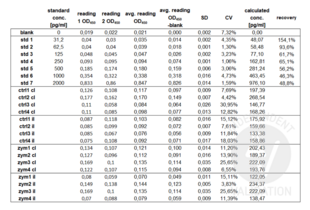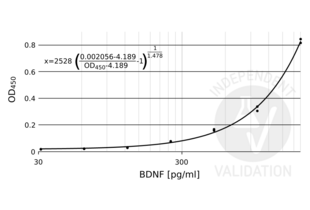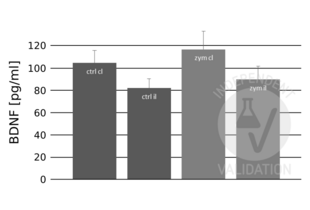BDNF ELISA Kit
-
- Target See all BDNF ELISA Kits
- BDNF (Brain-Derived Neurotrophic Factor (BDNF))
- Binding Specificity
- AA 129-247
-
Reactivity
- Mouse
- Detection Method
- Colorimetric
- Method Type
- Sandwich ELISA
- Detection Range
- 31.2-2000 pg/mL
- Minimum Detection Limit
- 31.2 pg/mL
- Application
- ELISA
- Purpose
- Sandwich High Sensitivity ELISA kit for Quantitative Detection of Mouse BDNF
- Brand
- PicoKine™
- Sample Type
- Cell Culture Supernatant, Cell Lysate, Plasma (EDTA), Plasma (citrate), Plasma (heparin), Serum
- Analytical Method
- Quantitative
- Specificity
-
Expression system for standard: sf21
Immunogen sequence: H129-R247 - Cross-Reactivity (Details)
- There is no detectable cross-reactivity with other relevant proteins.
- Sensitivity
- <2pg/mL
- Material not included
- Microplate reader in standard size. Automated plate washer. Adjustable pipettes and pipette tips. Multichannel pipettes are recommended in the condition of large amount of samples in the detection. Clean tubes and Eppendorf tubes. Washing buffer (neutral PBS or TBS). Preparation of 0.01M TBS: Add 1.2g Tris, 8.5g Nacl
- Immunogen
-
Expression system for standard: sf21
Immunogen sequence: H129-R247 - Featured
- Discover our best selling BDNF ELISA Kit
-
-
- Application Notes
- Before using Kit, spin tubes and bring down all components to bottom of tube. Duplicate well assay was recommended for both standard and sample testing.
- Plate
- Pre-coated
- Protocol
- mouse BDNF ELISA Kit was based on standard sandwich enzyme-linked immune-sorbent assay technology. A monoclonal antibody from rat specific for BDNF has been precoated onto 96-well plates. Standards(sf21, H129-R247) and test samples are added to the wells, a biotinylated detection polyclonal antibody from goat specific for BDNF is added subsequently and then followed by washing with PBS or TBS buffer. Avidin-Biotin-Peroxidase Complex was added and unbound conjugates were washed away with PBS or TBS buffer. HRP substrate TMB was used to visualize HRP enzymatic reaction. TMB was catalyzed by HRP to produce a blue color product that changed into yellow after adding acidic stop solution. The density of yellow is proportional to the mouse BDNF amount of sample captured in plate.
- Assay Procedure
-
Aliquot 0.1 mL per well of the 2000pg/mL,1000pg/mL, 500pg/mL, 250pg/mL, 125pg/mL, 62.5pg/mL, 31.2pg/mL mouse BDNF standard solutions into the precoated 96-well plate. Add 0.1 mL of the sample diluent buffer into the control well (Zero well). Add 0.1 mL of each properly diluted sample of mouse cell culture supernates, serum or plasma(heparin, EDTA, citrate) to each empty well. See "Sample Dilution Guideline" above for details. It is recommended that each mouse BDNF standard solution and each sample be measured in duplicate.
- Assay Precision
-
- Sample 1: n=16, Mean(pg/ml): 105, Standard deviation: 3.57, CV(%): 3.4
- Sample 2: n=16, Mean(pg/ml): 436, Standard deviation: 16.13, CV(%): 3.7
- Sample 3: n=16, Mean(pg/ml): 1217, Standard deviation: 49.90, CV(%): 4.1,
- Sample 1: n=24, Mean(pg/ml): 136, Standard deviation: 9.24, CV(%): 6.8
- Sample 2: n=24, Mean(pg/ml): 524, Standard deviation: 38.25, CV(%): 7.3
- Sample 3: n=24, Mean(pg/ml): 1279, Standard deviation: 94.65, CV(%): 7.4
- Restrictions
- For Research Use only
-
- by
- Prof. Merighi, Laboratory of Neurobiology, Department of Veterinary Sciences, University of Turin
- No.
- #103751
- Date
- 04/18/2019
- Antigen
- BDNF
- Lot Number
- 3814117212
- Method validated
- ELISA
- Positive Control
Adult mouse spinal cord (2-3 months old). A total of 10 animals (5 zymosan-treated mice and 5 control mice) were used.
- Negative Control
blank control
- Notes
Passed. ABIN411259 was used to evaluate the effect of zymosan administration on the level of BDNF in the spinal cord.
- Primary Antibody
- Secondary Antibody
- Full Protocol
- Inject 20µl of a solution of 3mg/ml of zymosan A (zym) dissolved in PBS subcutaneously under the left hind paw of adult CD1 male mice (2-3 month old). Inject control mice with 20µl of PBS only.
- Anesthetize mice with an intraperitoneal injection of pentothal and sacrifice. Dissect out lumbar spinal cord segments L1–L6 separating the dorsal left segment from the dorsal right one.
- Freeze samples rapidly in liquid nitrogen and then store at -80°C.
- Homogenize samples in 100µl lysis buffer (150mM KCl, 20mM HEPES, 5mM MgCl2, 0.5mM DTT 0.5).
- Clarify lysates by centrifugation (2min, 10000g, 4°C) and determine protein concentration of the supernatant using Bradford assay (Sigma-Aldrich).
- Perform ELISA assay according to the kit protocol.
- Use two replicates for each standard and sample.
- Standard: prepare a total of 8 tubes. Add 200μl of the 10ng/ml standard stock solution into 800μl of sample diluent buffer in the first tube. Add 300μl of sample diluent buffer to tubes 2-7. Add 300μl of the standard solution from tube 1 to the second tube for a final volume of 600μl and mix. Repeat the operation for tubes 3 to 7.
- Add 100μl sample diluent buffer as blank standard into the control well and 100μl of diluted standards into the standard wells (31.25pg/ml, 62.5pg/ml, 125pg/ml, 250pg/ml, 500pg/ml, 1000pg/ml, 2000pg/ml).
- For test sample wells, add 90μl of sample diluent buffer and 10μl of sample without touching the side of the well.
- Cover the plate with plate sealer and incubate at 37°C for 90min.
- Discard the liquid by clapping the plate on an absorbent filter.
- Add 100μl of 1x biotinylated anti-mouse BDNF antibody into each well.
- Cover the plate with plate sealer and incubate at 37°C for 60min.
- Wash the plate by clapping the plate on an absorbent filter paper and filling each well with Wash Buffer. Leave the plate on a shaker for 1 minutes. Repeat for a total of four washes.
- Add 100μl of 1x Avidin-Biotin-Peroxidase Complex into each well.
- Cover the plate with plate sealer and incubate at 37°C for 30min.
- Remove plate sealer and washed the plate 5x as indicated above.
- Add 90μl of Color Developing Reagent into each well and incubate in the dark 25min at 37°C.
- Add 100μl of Stop solution into each well and we read the O.D. absorbance at 450nm immediately after in a microplate reader.
- Experimental Notes
Validation #103751 (ELISA)![Successfully validated 'Independent Validation' Badge]()
![Successfully validated 'Independent Validation' Badge]() Validation ImagesFull Methods
Validation ImagesFull Methods -
- Handling Advice
- Avoid multiple freeze-thaw cycles.
- Storage
- -20 °C,4 °C
- Storage Comment
- Store at 4°C for 6 months, at -20°C for 12 months. Avoid multiple freeze-thaw cycles
- Expiry Date
- 12 months
-
-
: "The behavioral and physiological effects of high-fat diet and alcohol consumption: Sex differences in C57BL6/J mice." in: Brain and behavior, Vol. 7, Issue 6, pp. e00708, (2018) (PubMed).
: "Lentivirus-mediated interleukin-1β (IL-1β) knock-down in the hippocampus alleviates lipopolysaccharide (LPS)-induced memory deficits and anxiety- and depression-like behaviors in mice." in: Journal of neuroinflammation, Vol. 14, Issue 1, pp. 190, (2018) (PubMed).
: "Spirulina maxima Extract Ameliorates Learning and Memory Impairments via Inhibiting GSK-3β Phosphorylation Induced by Intracerebroventricular Injection of Amyloid-β 1-42 in Mice." in: International journal of molecular sciences, Vol. 18, Issue 11, (2018) (PubMed).
: "Ondansetron ameliorates depression associated with obesity in high-fat diet fed experimental mice: An investigation-based on the behavioral, biochemical, and molecular approach." in: Indian journal of pharmacology, Vol. 49, Issue 4, pp. 290-296, (2018) (PubMed).
: "Chronic Hippocampal Abnormalities and Blunted HPA Axis in an Animal Model of Repeated Unpredictable Stress." in: Frontiers in behavioral neuroscience, Vol. 12, pp. 150, (2018) (PubMed).
: "Modulation of nuclear REST by alternative splicing: a potential therapeutic target for Huntington's disease." in: Journal of cellular and molecular medicine, (2017) (PubMed).
: "Resveratrol reversed chronic restraint stress-induced impaired cognitive function in rats." in: Molecular medicine reports, Vol. 16, Issue 2, pp. 2095-2100, (2017) (PubMed).
: "Differential Efficacy of Ketamine in the Acute versus Chronic Stages of Complex Regional Pain Syndrome in Mice." in: Anesthesiology, Vol. 123, Issue 6, pp. 1435-47, (2016) (PubMed).
: "Fingolimod induces neurogenesis in adult mouse hippocampus and improves contextual fear memory." in: Translational psychiatry, Vol. 5, pp. e685, (2016) (PubMed).
: "Granulocyte colony-stimulating factor promotes behavioral recovery in a mouse model of traumatic brain injury." in: Journal of neuroscience research, Vol. 94, Issue 5, pp. 409-23, (2016) (PubMed).
: "The effects of EGb761 on lipopolysaccharide-induced depressive-like behaviour in C57BL/6J mice." in: Central-European journal of immunology / Polish Society for Immunology and eleven other Central-European immunological societies, Vol. 40, Issue 1, pp. 11-7, (2015) (PubMed).
: "Brain neuroplastic changes accompany anxiety and memory deficits in a model of complex regional pain syndrome." in: Anesthesiology, Vol. 121, Issue 4, pp. 852-65, (2014) (PubMed).
-
: "The behavioral and physiological effects of high-fat diet and alcohol consumption: Sex differences in C57BL6/J mice." in: Brain and behavior, Vol. 7, Issue 6, pp. e00708, (2018) (PubMed).
-
- Target See all BDNF ELISA Kits
- BDNF (Brain-Derived Neurotrophic Factor (BDNF))
- Alternative Name
- BDNF (BDNF Products)
- Synonyms
- ANON2 ELISA Kit, BULN2 ELISA Kit, bdnf-A ELISA Kit, BDNF ELISA Kit, bdnf ELISA Kit, brain derived neurotrophic factor ELISA Kit, brain-derived neurotrophic factor ELISA Kit, brain-derived neurotrophic factor L homeolog ELISA Kit, brain-derived neurotrophic factor S homeolog ELISA Kit, BDNF ELISA Kit, Bdnf ELISA Kit, bdnf ELISA Kit, bdnf.L ELISA Kit, bdnf.S ELISA Kit
- Background
-
Protein Function: During development, promotes the survival and differentiation of selected neuronal populations of the peripheral and central nervous systems. Participates in axonal growth, pathfinding and in the modulation of dendritic growth and morphology. Major regulator of synaptic transmission and plasticity at adult synapses in many regions of the CNS.
Background: Brain-derived neurotrophic factor(BDNF) is a prosurvival factor induced by cortical neurons that is necessary for survival of striatal neurons in the brain. It is a secreted protein with the molecular weight of 27.8 kDa, consisting of 247 amino acids. It is known to promote neuronal survival and differentiation. BDNF shares substantial amino acid sequence identity with nerve growth factor(NGF). BDNF and neurotrophin-3(NT-3) are two recently cloned neurotrophic factors that are homologous to NGF. mRNA products of the BDNF and NT-3 genes are detected in the adult human brain, suggesting that these proteins are involved in the maintenance of the adult nervous system. BDNF and other neurotrophins are critically involved in long-term potentiation(LTP). BDNF-mediated LTP is induced postsynaptically. BDNF has trophic effects on serotonergic(5-HT) neurons in the central nervous system. BDNF has an essential maintenance function in the regulation of anxiety-related behavior and in food intake through central mediators in both the basal and fasted state. It plays a role in treating breathing disorders such as respiratory insufficiency after spinal injury. The mature form of BDNF is identical in all mammals examined, and the gene encoding human BDNF to chromosome 11, band p13.
Synonyms: Brain-derived neurotrophic factor,BDNF,Bdnf,
Full Gene Name: Brain-derived neurotrophic factor
Cellular Localisation: Secreted. - Gene ID
- 12064
- UniProt
- P21237
- Pathways
- RTK Signaling, Synaptic Membrane, Feeding Behaviour, Dicarboxylic Acid Transport, Regulation of long-term Neuronal Synaptic Plasticity
-




 (12 references)
(12 references) (1 validation)
(1 validation)



